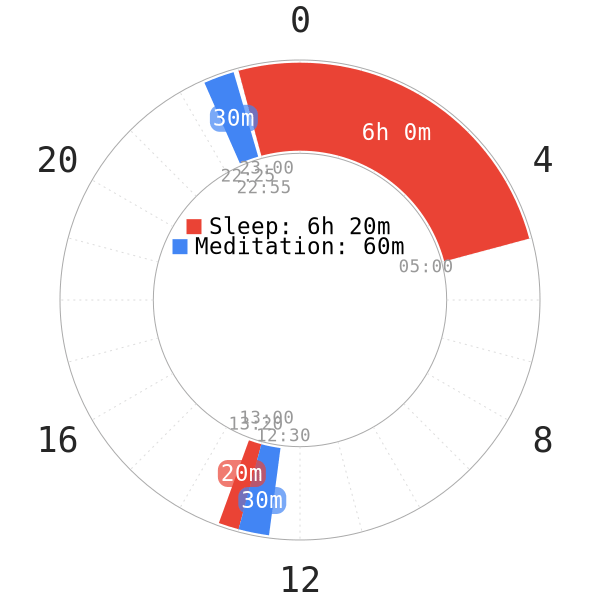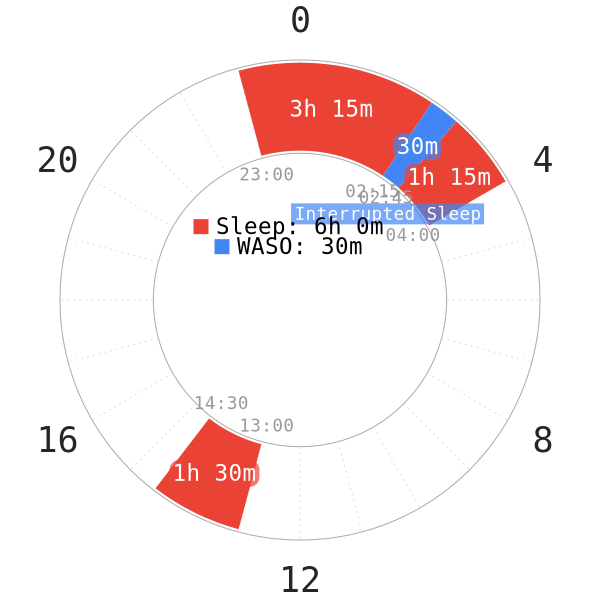Introduction to yoga
Yoga is a sum of multiple spiritual discipline practices that originate from India. These practices include, but not limited to, stretching, breath control, meditation, guided relaxation and static postures1,2. One of the core premises of this practice is to achieve balance and calmness in the mind. A lot of benefits of yoga have been recorded with little to no adverse effects.
Up to date, there are a few polyphasic sleepers who practice yoga, with decent to good results for nocturnal sleep. However, more research is necessary to correlate meditative activities with polyphasic sleep. The recommended focus would be on schedules with less total sleep and more shortened nocturnal core sleep. At face value and current anecdotal reports, yoga is a positive addition to most polyphasic sleepers’ lifestyle.
Acknowledged benefits of yoga
There are many variants of yoga in existence; as a result, there are multiple research reports on different types.
- One study about yoga asana practice concluded that 26 healthy adults aged from 20 to 58 benefited from the following yoga’s therapeutic effects. They were able to reduce stress, decrease blood pressure and increase muscular strength, endurance and stamina3. The age range of participants from the study indicates that many different age groups can benefit from yoga techniques.
- There are also multiple other studies on how potent yoga works on balancing the mind, increasing physical strength and boosting personal well-being.
In terms of sleep, yoga has also demonstrated its potency in raising overall sleep quality. This includes:
- Deeper sleep
- Reducing wake after sleep onset (WASO)1 and sleep onset latency1,4
- Improving sleep efficiency1,2,6,7
- Alleviating insomnia symptoms6
The side benefits resulting from these quality of life improvements include better cognitive functions at school. This is very necessary for teens who are often perpetually sleep deprived. In addition, they also often experience interrupted sleep. Practicing yoga could lead to better learning, better control in mood and memory and several other benefits.
It is worth noting that researchers conducted those studies with different types of subjects. Specifically, the wide range of subjects includes the elderly, pregnant women, cancer subjects and even small children (aged 3-4).
In what ways can yoga help polyphasic sleep?
Unfortunately, there has been no research between how yoga directly affects polyphasic sleep. It is also unclear if yoga is fully compatible with polyphasic sleeping, and if so, to what extent. All linked research articles in this blog post apply to normal monophasic nocturnal sleep, with the exception of one. However, polyphasic sleep can still make use of certain aspects of yoga. The following two aspects are main discussion topics as first-time polyphasic sleepers often concern about them.
Reducing sleep onset latency
In the study about small children, it was shown that a mere 5-minute yoga session can facilitate falling asleep in daytime naps4. From this study and indirect implications of other studies, it seems reasonable that yoga at least suits biphasic sleeping lifestyles. Being able to fall asleep in naps is a great asset to train napping skills and make use of napping abilities to transition into other polyphasic patterns of choice.
Up to date, there are few cases that regularly practice yoga (at least most days of the week) while staying on different biphasic schedules. They do report great success. Most of these cases have a good start into adaptation, with no trouble falling asleep at night thanks to the consistent sleep time of nocturnal sleep.

The potentially greater implication is that practicing yoga some time before a nap or a core is a good idea.
- This is a practice of cooling down and relaxing the brain before sleeping. Additionally, this can especially help schedules with a decent amount of total sleep, like Everyman 1. The reason is that sleep pressure on these schedules is usually low for the first couple weeks; thus, beginner nappers may have trouble falling asleep in the short nap.
- Working up the brain close to sleep times will make falling asleep much more difficult!
All in all, being able to fall asleep faster is a great benefit from yoga.
Reducing wake after sleep onset duration
WASO remains a big threat during adaptation to polyphasic schedules, especially schedules with higher total sleep time. These schedule groups tend to have a decently long, uninterrupted core sleep at night. WASO, by definition, is nocturnal awakenings for different reasons (e.g, bathroom use, awakening from a dream, slight noises). This results in certain periods of wake time before one can go back to sleep.

- This sleep interruption can often result in unrestful wakes in the morning. This is because interrupted sleep can alter sleep cycle and affect the sleep stage at the moment of awakening.
- However, common, normal WASO duration in healthy women is estimated to be 5-10% of TST; beyond 15% (at least 1h) is a major red flag5.
- Approximately the second-trimester group who practiced yoga was able to reduce 3% of WASO duration5.
Biphasic sleepers who practice yoga in the community report to have no problems sleeping through the long core sleep. This implies that their WASO duration is often minimal. Even if nocturnal awakening occurs (e.g, bathroom use), they have no trouble going back to bed. These biphasic patterns also include:
- Reducing variants (reduce TST compared to monophasic baseline)
- Non-reducing variants (having similar TST to monophasic baseline).
Under the context of long nocturnal sleep, yoga also improves TST by extending sleep duration. Sleep deprivation from restricted sleep results in poorer performance under quizzes and tests despite more wake time for studying1. This can be inferred that yoga enhances sleep quality and architecture. However, polyphasic sleep is usually not the same as nocturnal monophasic sleep; that being said, one should look at such comparisons between sleep deprivation and more wake time with a grain of salt.
In what ways can it hurt polyphasic sleeping?
Despite its hefty potential, yoga may have more limited effects on extreme polyphasic schedules. On these schedules, homeostatic pressure is overall higher. This in return facilitates falling asleep and reduces sleep onset duration on their own. And since all sleep blocks are shorter compared to those on milder schedules, polyphasic sleepers may or may not have run into any WASOs.
Thus, it is unknown if yoga drastically improves these aspects of sleep quality on these polyphasic schedules compared to higher TST schedules.
Risk of oversleeping
During polyphasic adaptation (where sleep deprivation usually gets to an intense or uncomfortable level), closing eyes can initiate sleep and cause an involuntary oversleep. This situation is very similar to microsleeping, which is dozing off for a couple seconds without awareness. Therefore, it is important to keep your eyes open during the adaptation period when it is not time to sleep on your schedule yet.
- A lot of common yoga exercises (e.g, meditation), however, require or at least recommend closing your eyes for better focus. But as of now, meditating in certain postures (e.g, Tree Pose) is possible with open eyes8.
- You should open your eyes because closing them can generate more daydreaming, like you are trying to run away from them. Meanwhile, opening your eyes keeps you still and your line of sight connects you to the present state9.
Alternatively, there are also yoga positions that favor standing up instead of sitting.
- Sitting with open eyes can potentially still induce sleep with enough sleep deprivation.
- Such yoga activities include the Mountain Pose, Chair Pose, and Triangle Pose, to name a few10.
Thus, you definitely should keep your eyes open during these meditating activities and choose standing poses when you are adapting. This would prevent accidentally falling asleep in the process. Doing so can mess with the timing of the following sleep sessions and also counts as an oversleep.
Conclusion
To sum up, yoga promises good prospects for polyphasic sleeping. It helps with two of the biggest concerns during the adaptation period, sleep onset duration and WASO duration. However, more experiments are necessary to determine how much effect yoga has on more extreme polyphasic schedules.
The potential downside of yoga is that it can trigger microsleeping during adaptation. Thus, closing your eyes in yoga activities during adaptation is discouraged. Regardless, no negative reports have been collected from more difficult polyphasic schedules. It is then reasonable to add yoga to the polyphasic regime without much damage, as of the current date.
Main author: GeneralNguyen
Page last updated: 26 December 2020
Reference
- M. Perfect, M., & Smith, B. (2016). Hypnotic relaxation and yoga to improve sleep and school functioning. International Journal of School & Educational Psychology, 4(1), 43–51. doi:10.1080/21683603.2016.1130558.
- Wikipedia Contributors. “Yoga.” Wikipedia, Wikimedia Foundation, 30 Jan. 2019, en.wikipedia.org/wiki/Yoga. Accessed 4 March. 2020.
- Cowen, V. S., & Adams, T. B. (2005). Physical and perceptual benefits of yoga asana practice: results of a pilot study. Journal of Bodywork and Movement Therapies, 9(3), 211–219. doi:10.1016/j.jbmt.2004.08.001
- Henderson, Natalie. “Yoga Before Naptime.” Masters of Arts in Education Action Research Papers, 1 May 2018, sophia.stkate.edu/maed/264/. Accessed 4 Mar. 2020.
- Bankar, M., Chaudhari, S., & Chaudhari, K. Impact of long term Yoga practice on sleep quality and quality of life in the elderly. Journal of Ayurveda and Integrative Medicine. 2013;4(1):28. doi:10.4103/0975-9476.109548 [PubMed]
- Mustian, Karen M. “Yoga as Treatment for Insomnia Among Cancer Patients and Survivors: A Systematic Review.” European Medical Journal. Oncology. 2013;1(1):106–115. [PubMed]
- Beddoe, A. E., Lee, K. A., Weiss, S. J., Powell Kennedy, H., & Yang, C.-P. P. Effects of Mindful Yoga on Sleep in Pregnant Women: A Pilot Study. Biological Research For Nursing. 2010;11(4):363–370. doi:10.1177/1099800409356320. [PubMed]
- “Should You Keep Your Eyes Open in Yoga.” Melissawest.Com, melissawest.com/keeping-eyes-open-in-yoga/. Accessed 10 Mar. 2020.
- Naughton, Julia. “Meditating With Your Eyes Open: A Guide.” Huffington Post, 13 Jan. 2016, www.huffingtonpost.com.au/2016/01/12/meditating-with-eyes-open_n_8965240.html. Accessed 10 Mar. 2020.
- “Basic Yoga Moves Cheat Sheet.” Greatist, greatist.com/move/common-yoga-poses#easy. Accessed 12 Mar. 2020.
